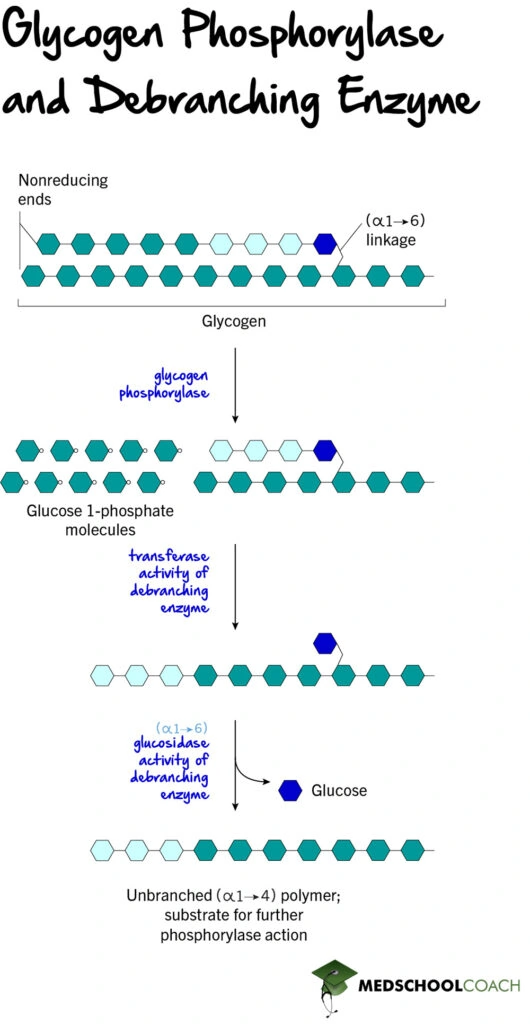Glycogen Structure & Glycogenolysis
MCAT Biochemistry Chapter 5 - Section 2.1 - Metabolic Pathways - Glycogen Structure & Glycogenolysis
- Home
- »
- MCAT Masterclass
- »
- Biological and Biochemical Foundations of Living Systems
- »
- Biochemistry
- »
- Glycogen Structure & Glycogenolysis – MCAT Biochemistry
Sample MCAT Question - Glycogen Structure & Glycogenolysis
Glycogen branches are attached to linear glycogen chains by which type of bond?
a) α-1,4 linkages
b) α-1,5 linkages
c) α-1,6 linkages
d) α-1,7 linkages
C is correct. α-1,6 linkages.
Glycogen has a branched structure that allows for rapid mobilization and breakdown of glucose molecules. The straight chains in glycogen are held together by α-1,4 linkages, while the branches are formed from α-1,6 linkages. Answer choices B and D are incorrect because glycogen does not form these types of linkages. Moreover, glucose is a six carbon and, therefore, cannot have 1,7 linkages.
Get 1-on-1 MCAT Tutoring From a Specialist
With MCAT tutoring from MedSchoolCoach, we are committed to help you prepare, excel, and optimize your ideal score on the MCAT exam.
For each student we work with, we learn about their learning style, content knowledge, and goals. We match them with the most suitable tutor and conduct online sessions that make them feel as if they are in the classroom. Each session is recorded, plus with access to whiteboard notes. We focus on high-yield topics if you’re pressed for time. If you have more time or high-score goals, we meticulously cover the entire MCAT syllabus.
Glycogen Overview
Glycogen is a glucose polymer that can be readily synthesized and broken down to release glucose for ATP production. Together, these processes are known as glycogen metabolism. This post is the first of two posts on glycogen and glycogen metabolism. In this post, we’ll cover glycogen’s structure and function, as well as glycogenolysis, the process by which glycogen chains are broken down into glucose monomers. Then in the second post, we’ll cover glycogenesis (the process by which glycogen is synthesized from glucose) and the hormonal regulation of glycogen pathways.
Glycogen Structure and Function
Figure 1 shows the structure of glycogen. It has many branches made up of glucose molecules. This multibranched structure allows for the rapid mobilization of glucose, as free glucose molecules can be broken off of the branches and quickly transported to places of need. Several linkages hold the glucose monomers that make up glycogen together. Straight chain regions of glycogen consist of glucose monomers held together by α-1,4 linkages, while the branching points of glycogen are held together by α-1,6 linkages.

Glycogen is primarily stored in liver and skeletal muscle cells. As a result of its branched polymer structure, glycogen can store large quantities of glucose in cells without affecting cellular osmolarity. For example, in a hepatocyte, or liver cell, if glucose were not stored as glycogen, the glucose concentration would be about 0.4 M. This concentration is considerably large for a single cell. However, when glucose is stored as glycogen, its concentration is approximately .01 μM, which is much more reasonable for a single cell.
Glycogenolysis
Glycogenolysis is the process of breaking down glycogen into glucose monomers. This process involves several steps. Figure 2 shows the reaction catalyzed by the enzyme glycogen phosphorylase, the first enzyme involved in glycogenolysis. As a phosphorylase enzyme, glycogen phosphorylase uses an inorganic phosphate to break the α-1,4 linkages in glycogen, freeing glucose-1-phosphate molecules.

Phosphoglucomutase then converts glucose-1-phosphate into glucose 6-phosphate. In hepatocytes, glucose-6-phosphate can then be converted to glucose by glucose-6-phosphatase and released into the bloodstream to regulate and maintain glucose levels. Skeletal muscles, on the other hand, lack the enzyme glucose-6-phosphatase, and therefore cannot release glucose into the body. The reason for this is because skeletal muscle cells are storing glycogen for their own use, therefore, the glucose-6-phosphate formed feeds directly into glycolysis.
Glycogenolysis: Branch Point Degradation
Once four glucose molecules are left on a glycogen branch, glycogen phosphorylase can no longer break off glucose-1-phosphate monomers. Instead, debranching enzyme takes over (Figure 3). Debranching enzyme has two main functions: a transferase function and a glucosidase function. In terms of its transferase function, the debranching enzyme will transfer a segment of three glucose residues from an α-1,6 branch onto a nearby branch of the glycogen chain. Then functioning as a glucosidase, it will cleave the α-1,6 linkage holding the single remaining glucose molecule, producing a free glucose molecule. Glycogen phosphorylase will then continue breaking apart the extended branch as needed.

If you found this article useful, check out our other post which covers glycogenesis and the hormonal regulation of glycogen pathways.
Explore More MCAT Masterclass Chapters
Take a closer look at our entire MCAT Masterclass or explore our Biochemistry lessons below.

One-on-One Tutoring
Are you ready to take your MCAT performance to a whole new level? Work with our 99th-percentile MCAT tutors to boost your score by 12 points or more!
See if MCAT Tutoring can help me
Talk to our enrollment team about MCAT Tutoring

MCAT Go Audio Course
Engaging audio learning to take your MCAT learning on the go, any time, any where. You'll be on the way to a higher MCAT score no matter where you are. Listen to over 200+ lessons.

MCAT Practice Exams
Practice makes perfect! Our mock exams coupled with thorough explanations and in-depth analytics help students understand exactly where they stand.

MCAT Prep App
Access hundreds of MCAT videos to help you study and raise your exam score. Augment your learning with expert-created flashcards and a question banks.
